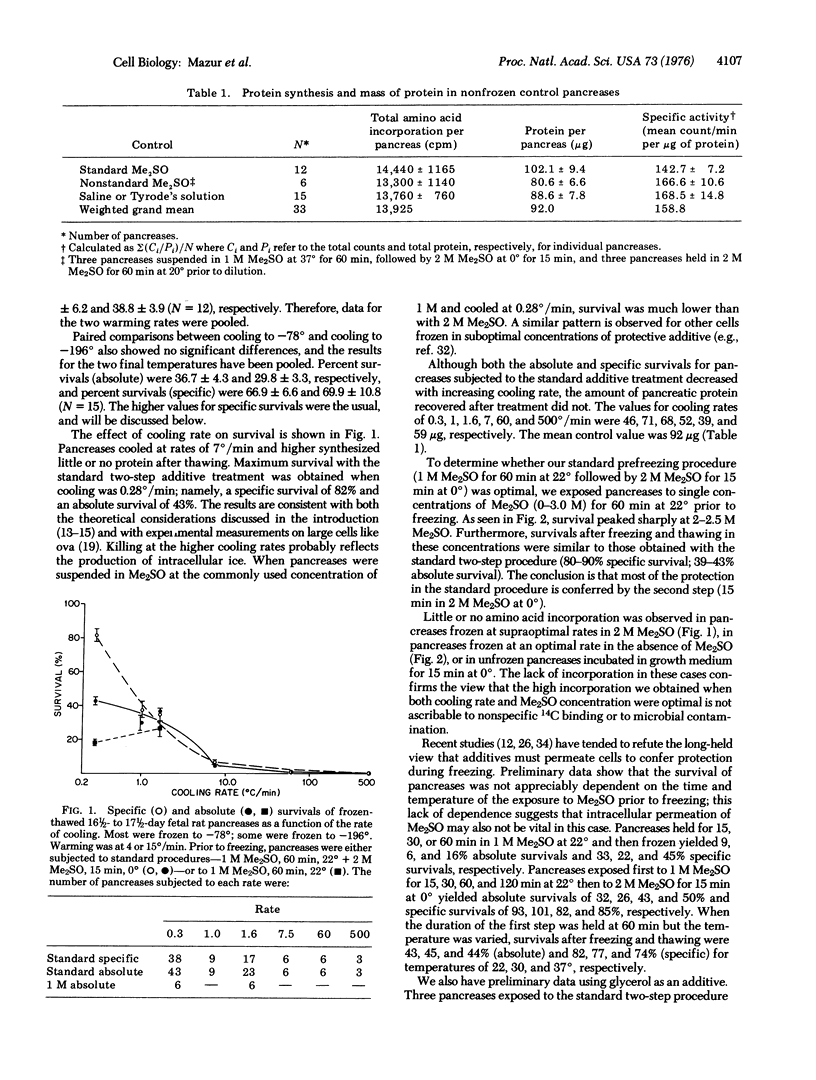Abstract
Transplantation of pancreases may have clinical utility in the treatment of diabetes, for it has been shown that chemically induced diabetes in rats can be reversed by the transplantation of greater than or equal to four syngeneic fetal pancreases. Allogeneic transplants produce serious immunological problems, but the problems could be ameliorated if tissue-typed organs could be stored in the frozen state. Unfortunately, nearly all attempts to freeze organs have failed. Nevertheless, recent developments in the physical-chemical analysis of freezing injury and its successful application to the freezing of mammalian embryos encouraged us to attempt the freezing of 16 1/2- to 17 1/2-day intact fetal pancreases. The analysis indicated that to achieve success pancreases would have to be cooled less than 1 degree/min and diluted extremely slowly after thawing. Experiments with embryos and red cells indicated that high survivals might require high concentrations of protective solutes and slow warming. These predictions were accurate. After freezing to -78 or -196 degrees and thawing under optimal conditions, the fetal pancreases synthesized 80-100% as much protein as unfrozen controls and they yielded viable allografts. Optimal conditions included suspension in 2 M dimethylsulfoxide, freezing at 0.3 degrees/min, and slow dilution to preclude osmotic shock.
Full text
PDF




Selected References
These references are in PubMed. This may not be the complete list of references from this article.
- Bank H., Maurer R. R. Survival of frozen rabbit embryos. Exp Cell Res. 1974 Nov;89(1):188–196. doi: 10.1016/0014-4827(74)90201-8. [DOI] [PubMed] [Google Scholar]
- Bank H., Mazur P. Visualization of freezing damage. J Cell Biol. 1973 Jun;57(3):729–742. doi: 10.1083/jcb.57.3.729. [DOI] [PMC free article] [PubMed] [Google Scholar]
- Brown J., Clark W. R., Molnar I. G., Mullen Y. S. Fetal pancreas transplantation for reversal of streptozotocin-induced diabetes in rats. Diabetes. 1976 Jan;25(1):56–64. doi: 10.2337/diab.25.1.56. [DOI] [PubMed] [Google Scholar]
- Brown J., Molnar I. G., Clark W., Mullen Y. Control of experimental diabetes mellitus in rats by transplantation of fetal pancreases. Science. 1974 Jun 28;184(4144):1377–1379. doi: 10.1126/science.184.4144.1377. [DOI] [PubMed] [Google Scholar]
- Clark W. R., Rutter W. J. Synthesis and accumulation of insulin in the fetal rat pancreas. Dev Biol. 1972 Dec;29(4):468–481. doi: 10.1016/0012-1606(72)90084-x. [DOI] [PubMed] [Google Scholar]
- Diller K. R. Intracellular freezing: effect of extracellular supercooling. Cryobiology. 1975 Oct;12(5):480–485. doi: 10.1016/0011-2240(75)90029-2. [DOI] [PubMed] [Google Scholar]
- Karow A. M., Jr, Webb W. R. Toxicity of various solute moderators used in hypothermia. Cryobiology. 1965 Mar-Apr;1(4):270–273. doi: 10.1016/0011-2240(65)90033-7. [DOI] [PubMed] [Google Scholar]
- LOVELOCK J. E. The haemolysis of human red blood-cells by freezing and thawing. Biochim Biophys Acta. 1953 Mar;10(3):414–426. doi: 10.1016/0006-3002(53)90273-x. [DOI] [PubMed] [Google Scholar]
- Leibo S. P., Farrant J., Mazur P., Hanna M. G., Jr, Smith L. H. Effects of freezing on marrow stem cell suspensions: interactions of cooling and warming rates in the presence of PVP, sucrose, or glycerol. Cryobiology. 1970 Jan-Feb;6(4):315–332. doi: 10.1016/s0011-2240(70)80086-4. [DOI] [PubMed] [Google Scholar]
- Leibo S. P., Mazur P., Jackowski S. C. Factors affecting survival of mouse embryos during freezing and thawing. Exp Cell Res. 1974 Nov;89(1):79–88. doi: 10.1016/0014-4827(74)90189-x. [DOI] [PubMed] [Google Scholar]
- MAZUR P. KINETICS OF WATER LOSS FROM CELLS AT SUBZERO TEMPERATURES AND THE LIKELIHOOD OF INTRACELLULAR FREEZING. J Gen Physiol. 1963 Nov;47:347–369. doi: 10.1085/jgp.47.2.347. [DOI] [PMC free article] [PubMed] [Google Scholar]
- Mazur P. Cryobiology: the freezing of biological systems. Science. 1970 May 22;168(3934):939–949. doi: 10.1126/science.168.3934.939. [DOI] [PubMed] [Google Scholar]
- Mazur P., Leibo S. P., Miller R. H. Permeability of the bovine red cell to glycerol in hyperosmotic solutions at various temperatures. J Membr Biol. 1974;15(2):107–136. doi: 10.1007/BF01870084. [DOI] [PubMed] [Google Scholar]
- Mazur P., Miller R. H., Leibo S. P. Survival of frozen-thawed bovine red cells as a function of the permeation of glycerol and sucrose. J Membr Biol. 1974;15(2):137–158. doi: 10.1007/BF01870085. [DOI] [PubMed] [Google Scholar]
- Mazur P., Schmidt J. J. Interactions of cooling velocity, temperature, and warming velocity on the survival of frozen and thawed yeast. Cryobiology. 1968 Jul-Aug;5(1):1–17. doi: 10.1016/s0011-2240(68)80138-5. [DOI] [PubMed] [Google Scholar]
- Mazur P. The role of cell membranes in the freezing of yeast and other single cells. Ann N Y Acad Sci. 1965 Oct 13;125(2):658–676. doi: 10.1111/j.1749-6632.1965.tb45420.x. [DOI] [PubMed] [Google Scholar]
- Mazur P. Theoretical and experimental effects of cooling and warming velocity on the survival of frozen and thawed cells. Cryobiology. 1966 Jan-Feb;2(4):181–192. doi: 10.1016/s0011-2240(66)80165-7. [DOI] [PubMed] [Google Scholar]
- McGrath J. J., Cravalho E. G., Huggins C. E. An experimental comparison of intracellular ice formation and freeze-thaw survival of HeLa S-3 cells. Cryobiology. 1975 Dec;12(6):540–550. doi: 10.1016/0011-2240(75)90048-6. [DOI] [PubMed] [Google Scholar]
- Miller R. H., Mazur P. Survival of frozen-thawed human red cells as a function of cooling and warming velocities. Cryobiology. 1976 Aug;13(4):404–414. doi: 10.1016/0011-2240(76)90096-1. [DOI] [PubMed] [Google Scholar]
- Towill L. E., Mazur P. Osmotic shrinkage as a factor in freezing injury in plant tissue cultures. Plant Physiol. 1976 Feb;57(2):290–296. doi: 10.1104/pp.57.2.290. [DOI] [PMC free article] [PubMed] [Google Scholar]
- Whittingham D. G., Leibo S. P., Mazur P. Survival of mouse embryos frozen to -196 degrees and -269 degrees C. Science. 1972 Oct 27;178(4059):411–414. [PubMed] [Google Scholar]
- Whittingham D. G. Survival of mouse embryos after freezing and thawing. Nature. 1971 Sep 10;233(5315):125–126. doi: 10.1038/233125a0. [DOI] [PubMed] [Google Scholar]
- Wilmut I. The effect of cooling rate, warming rate, cryoprotective agent and stage of development on survival of mouse embryos during freezing and thawing. Life Sci II. 1972 Nov 22;11(22):1071–1079. doi: 10.1016/0024-3205(72)90215-9. [DOI] [PubMed] [Google Scholar]


